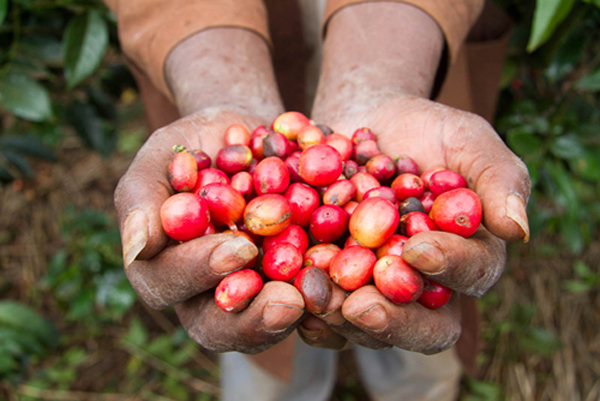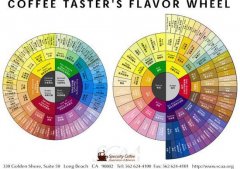Three native species of coffee: Arabica, Robusta and Liberia

Coffee belongs to the evergreen shrub of the genus Rubiaceae, which is centered in the tropics. There are about 6000 species of Rubiaceae belonging to 500 genera. Coffee has always been considered to have certain effects, such as invigorating the stomach, waking up the brain, stopping bleeding, dissipating heat, strengthening the body and so on. There are about 40 species of coffee plants, but the only ones that can produce coffee beans of commercial value are Arabica, Robusta and Liberian. these three species are called the "three native species of coffee".
Arabica species:
The origin of Arabica species is the Abyssinia Plateau of Ethiopia (now the Ethiopian Plateau). It developed the habit of baking and drinking in the 13th century and was introduced into Europe from the Arab region in the 16th century. it has become a favorite drink all over the world.
Arabica coffee accounts for 75% of all coffee, accounting for 80%. It has excellent flavor and aroma, making it the only coffee that can be drunk directly among these native species. But its resistance to dryness, frost, diseases and insect pests is too low, especially the natural enemy of coffee-leaf rust. Sri Lanka is a case in point. Sri Lanka used to be a well-known coffee producer, but coffee farms were not spared by leaf rust at the end of the 19th century. Since then, Sri Lanka has turned to the development of black tea industry, and the same list of black tea estates as India.
Arabica coffee beans are mainly grown in South America (except parts of Argentina and Brazil), Central America, Africa (Kenya, Ethiopia, etc.), Asia (including parts of Yemen, India and Papua New Guinea).
Robusta species:
The leaf rust-resistant varieties found in Congo in Africa have stronger disease resistance than Arabica. In fact, the Robusta species was originally a mutant of the Congolese species.
Arabica coffee beans grow in the cold tropical high-sea areas, and the high-temperature and humid zone that is not suitable for Arabica coffee is where Robsta coffee grows. Robusta species are commonly used in instant coffee (which extracts about twice as much liquid as Arabica), bottled coffee, liquid coffee and other industrial coffees. The content of caffeine is about 3.2%, much higher than 1.5% of Arabica species.
The main producing countries are Indonesia, Vietnam and West Africa with C ô te d'Ivoire, Algeria and Angola as the center.
Liberian species:
West Africa is the origin of coffee grown in Liberia. It has a strong ability to adapt to all kinds of environments, whether high or low temperature, humid or dry, except that it is not resistant to leaf rust and its flavor is worse than that of Arabica, so it is only traded in some West African countries (Libya, C ô te d'Ivoire, etc.). Or planted for research.
About 65% of the coffee in circulation in the world market is Alibika:
According to the statistics of ICO (International Coffee Organization), excluding the domestic transactions of coffee-producing countries, about 65% of the coffee in circulation in the world market is Arabica and 35% is robusta. Arabica species are characterized by slender and flat grains, while robusta coffee beans are more round.
But if you add in the hybrids of Arabica and robusta (for example, the mutant Colombian subspecies, which is the main variety of Colombian coffee, has a 1x4 robusta pedigree and is therefore resistant to leaf rust and has high yield) and its mutant secondary coffee beans, the classification will be more complicated. Some Arabica coffee beans are quite close to the native species, while others are similar to the Robusta species.
Important Notice :
前街咖啡 FrontStreet Coffee has moved to new addredd:
FrontStreet Coffee Address: 315,Donghua East Road,GuangZhou
Tel:020 38364473
- Prev

How to choose the variety and proportion of coffee beans when blending coffee beans?
[FelixLin's answer (14 votes)]: thank you for inviting me! In terms of personal experience, I generally follow the principle of sweet and sour balance, that is, no matter what kind of beans, or what kind of baking degree, I will first test these beans, feel the sweet and sour feeling of coffee beans! If you give me two coffee beans now, I will first test the sweet and sour feeling of these two coffee beans, and then
- Next

How to distinguish between coffee beans and coffee beans
(source: Zhihu author: Auli) as a coffee industry, I also do not like to impose professional knowledge on others, leaving the specialty to us and reducing the learning cost of users as much as possible should be the truth of mass consumer goods. SCAA or SCAE's CUPPING standard can be read in a book. The usual treatment method and the learning cost of various flavors, flavor wheels and so on in each producing area.
Related
- Guji coffee producing area of Guji, Ethiopia: Humbela, Shakiso, Wulaga
- What is the most expensive variety of Qiloso in BOP multi-variety group?
- How to store the coffee beans bought home?
- Why are Yemeni coffee beans so rare now?
- Ethiopian Sidamo all Red Fruit Sun Sun Santa Vini Coffee beans
- SOE is mostly sour? What does it mean? Is it a single bean? what's the difference between it and Italian blending?
- Is Italian coffee beans suitable for making hand-brewed coffee?
- How to choose coffee beans when making cold coffee? What kind of coffee beans are suitable for making cold coffee?
- Just entered the pit to make coffee, what kind of coffee beans should be chosen?
- Can only Japan buy real Blue Mountain Coffee? What are authentic Jamaican Blue Mountain coffee beans?

